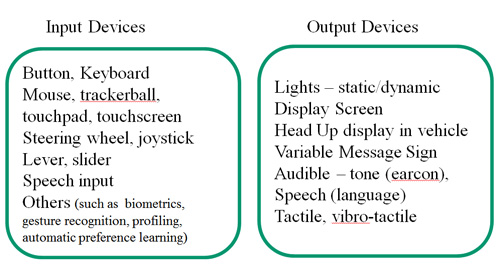
Road Network Operations
& Intelligent Transport Systems
A guide for practitioners!

Road Network Operations
& Intelligent Transport Systems
A guide for practitioners!
Humans can interact with the outside world, including ITS, in myriad ways and there is a wide variety of technology available to assist this interaction. The most common HMI components used are described here. HMI elements – good, poor and indifferent – are invariably present in computer systems and ITS. For example:
Public displays may also incorporate important HMI features – such as:
It is a commonly-held ‘truth’ that people have five basic senses:
In fact people have others senses as well, including: vestibular (balance and movement), kinaesthetic (relative position of parts of the body), pain, a sense of temperature and a sense of time passing. All these allow people to interpret the world around them, at different levels.
There is a wide range of human machine interface components to support the interaction between road users and ITS.

Use of hardware (such as buttons and a display screen) allow road users to interact and to develop a dialogue with the ITS technology. The extent to which the dialogue is efficient and effective (and liked by the user) depends both on the detailed design and performance of the interface hardware and also the design structure of the dialogue.
The designer of the HMI has a very wide range of choices. For example, in hardware design, buttons can be “latching” (they maintain their state after being activated) or “non-latching” (momentary) with different sizes, shapes and clearances to other buttons, different levels of resistance and sensitivity. The hardware design may also take account of implicit associations and knowledge of users (such as a familiar shape or icon and colour – such as red for danger).
The design of the dialogue (its structure and management) is also very important to promote ease of use. Important issues include: length of “timeouts”, language used and menu structure.
Although the design of the HMI of vehicles is the domain of the automotive manufacturer, in-vehicle HMI is often supplemented by drivers with the addition of mobile communications and information systems. These may or may not be designed for use while driving and their use can have a significant effect on drivers.
Choice of HMI is a specialist area, and advice from human factors professionals is recommended. The HMI should be based on:
There may be a trade-off between ease of learning and ease of use.
Try it with new users – what is their experience? (See Piloting, Feedback and Monitoring)
To be effective, all transport signs need to be noticed, understood and followed. Much has been studied and written about the human factors of road signage. Signage should be considered as part of an overall information provision strategy for road users. There will also be human factors considerations in its construction, installation and maintenance.
Variable Message Signs (VMS) are a typical form of ITS, particularly used on interurban roads to convey messages to drivers. Key considerations for VMS include:
Design of vehicles including their HMI is the domain of vehicle manufacturers who consider the “look and feel” of their vehicle’s HMI as part of their brand image.
Information and communication systems may be factory-fitted, fitted as an aftermarket option or (more commonly) brought into the vehicle by the driver. Examples include SatNav guidance systems and fee collection transponders. Some countries have legislation restricting the use of specific devices such as hand-held mobile phones. The HMI of in-vehicle devices may or may not be suitable for use while driving and road operators should be aware that use of such “secondary” interfaces by drivers may contribute to inattention and distraction.
Some Road Operators and other information brokers have sought to use data provided by large numbers of transport users to help road performance. This is called “crowdsourcing” which uses location and communication information from smart devices. The engagement of users may be implicit as a result of their use of other services, or may require more explicit participation. Increased engagement and richer data may be sought by offering interaction and competition (“gamification” – turning it into a game) or by using user-derived content from social media. There are privacy issues to consider, but road users may be willing to engage in services that offer benefits to them, such as ride sharing.